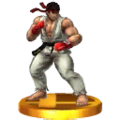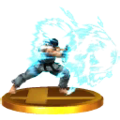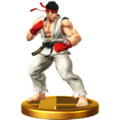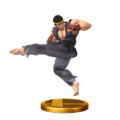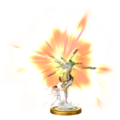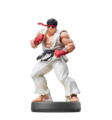Ryu (SSB4): Difference between revisions
Bowserboy3 (talk | contribs) No edit summary |
|||
| Line 215: | Line 215: | ||
*{{Sm|Aki|Japan|p=Japan}} | *{{Sm|Aki|Japan|p=Japan}} | ||
*{{Sm|False|USA}} | *{{Sm|False|USA}} | ||
===Tier placement and history=== | |||
Ever since his release, Ryu has been considered a very viable character. The control input carryover from the ''Street Fighter'' series benefitted Ryu immensely, giving him excellent combo potential on his attacks out of grounded, repeated weak moves, while also giving him improved versions of three of his special attcks, namely his Shoryuken becoming a fearsome KO option at relatively low percentages. This gave him excellent tournament representation and results for his DLC status, namely from smashers like {{Sm|9B}}, {{Sm|DJ Jack}}, {{Sm|Venom}} and, most notably, {{Sm|Trela}}. The nerfs to other top tier characters such as {{SSB4|Diddy Kong}} and {{SSB4|Sheik}} further contributed to his better status. Ryu's tier placement, however, was a great topic of debate due to his weaknesses, namely his trouble at approaching reliably, the buffs other characters had gained, and the release of {{SSB4|Cloud}}, a DLC character that was seen just as viable as him. Despite this, he was ranked 4th on the first ''4BR'' [[tier list]], becoming a top-tier character. | |||
Ryu's results would continue to decline due to the release of {{SSB4|Corrin}} and {{SSB4|Bayonetta}}, the buffs to {{SSB4|Mewtwo}} in game updates and the spike in popularity Cloud had gained. This caused some smashers to drop him and reduced his tournament results significantly, which in turn made him rank at 9th on the second tier list, and eventually 12th on the third and current tier list. Ryu's strengths, while larger than some other top-tiered characters, are held back more than said characters by his weaknesses and very high learning curve and the dexterity to input his moves, and as such has deterred his tournament results from being as great as they initially were. | |||
==[[List of Super Smash Bros. 4 character trailers#Ryu|Reveal trailer]]== | ==[[List of Super Smash Bros. 4 character trailers#Ryu|Reveal trailer]]== | ||
Revision as of 15:21, March 3, 2017
| Ryu in Super Smash Bros. 4 | |
|---|---|
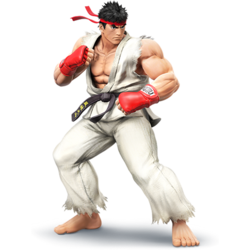 
| |
| Universe | Street Fighter |
| Availability | Downloadable |
| Final Smash | Shin Shoryuken / Shinku Hadoken |
| Tier | A (12) |
| “ | Here Comes A New Challenger! Ryu | ” |
| —Introduction tagline | ||
Ryu (リュウ, Ryū) is a playable character and newcomer in Super Smash Bros. 4. As the fourth downloadable character announced, Ryu was revealed and released alongside veterans Lucas and Roy on June 14th, 2015. Ryu is the fourth of six playable third-party characters for the game, alongside Sega's Sonic and Bayonetta, Bandai Namco's Pac-Man, fellow Capcom representative Mega Man, and Square Enix's Cloud. Ryu is voiced by Kyle Hebert in English and Hiroki Takahashi in Japanese, both of whom have voiced him since Street Fighter IV.
Ryu is ranked 12th out of 58 on the tier list, placing him in the last spot of the A tier; the lower end of the top tier, which incidentally makes him the last top tier character in the game. The control input carryover from the Street Fighter series benefits Ryu immensely, with his tapped attacks being useful combo starters and his held attacks being great combo finishers or potent KO options. This is made better by his multiple combo-breaking options such as Shoryuken, neutral air, and Focus Attack, all which have quick startup and make him surprisingly difficult to juggle, while the latter two also allow him to start damaging combos due to the good damage and speed of his moveset. His recovery is also resilient, as his entire special moveset grants him unpredictable ways to return to the stage. Finally, Ryu is exceedingly difficult to punish out of shield due to most of his moves having a hitlag multiplier of at least 1.8x.
However, Ryu's approach is problematic due to his below-average mobility (with the exception of his average dashing speed). Most notably, he carries over the "fixed arc" jumps from his series, giving him the lowest air acceleration in the game and making aerial approaches very committal. Additionally, his only projectile Hadoken is slow and very easily intercepted, while his ground attacks have short ranges. His grab game is also lackluster, since none of his throws can combo (barring down throw until 30%) or KO reliably. His recovery is also very easy to gimp if Shoryuken is his only available option, due to its fixed movement and inability to edge sweetspot until its later half. Finally, Ryu often suffers with "forcing" KOs, as he lacks reliable finishing moves outside of setups from Focus Attack or his tapped tilts, making it difficult for him to take stocks without starting a combo.
Due to possessing one of the highest learning curves in the game, Ryu's representation is merely average, unlike other highly ranking characters. Regardless, he has overall been very successful in competitive play, thanks to his extremely rewarding performance once mastered. However, despite his success and outstanding potential, Ryu's current ranking on the tier list is debatable. Though he has good tournament results from dedicated mains such as Trela, Darkshad and Locus, the more consistent and frequent tournament success of characters currently ranked below him, particularly Mewtwo, Bayonetta, Lucario, and Marth, has led many players to believe his current ranking is too high.
Attributes
Ryu is an average sized heavyweight with below average mobility and recovery, but possesses a mix of combo-based moves and finishing moves with very high knockback. Apart from these, some of his traits are similar to Mario's, such as his dashing speed and the individual damage output of his attacks. This owes to the fact that Ryu, like Mario, is an "all-rounder" in his home series. Despite his balanced attributes, however, Ryu has low jumping force and the single slowest air acceleration in the game. This makes his aerial approach somewhat difficult, while his walking speed (the third slowest in the game) can make his grounded approach difficult outside of dashing.
Ryu's controls are unique in the Super Smash Bros. series and attempt to emulate the control scheme of his home series. The strength of his attacks depend on how long the attack button is pressed; tapping the button initiates a weak attack, whereas holding the button initiates a strong attack. Additionally, his neutral, side and up special moves can be inputted using half-circle and quarter-circle motions plus either attack button for stronger variations. Generally, his tapped tilts are good at chaining with one another due to their low knockback and high speed, which gives him a unique combo-based damage-racking playstyle. This works by keeping opponents in hitstun before launching them away by ending any combo chain with a finisher (typically a held tilt attack or inputted special move), similar to the combos in his home series. Additionally, almost all of Ryu's special attacks (sans Focus Attack) gain benefits from using his unique button inputs, as they do more damage and knockback or have additional effects when done with inputs compared to just with the special button, making mastery of his button inputs imperative if the player wishes to deal higher damage and knockback at all times, especially since they can also be used as a reliable finisher for his tilt combo chains. Effectively, this means Ryu is the only character to have true combos from almost any tilt, allowing him to immediately and effectively switch from damage racking to a finisher instantaneously.
However, Ryu has some weaknesses, one of which is his recovery. Despite being very long-distanced overall, it is very short if many extendable elements, such as Focus Attack and Tatsumaki Senpukyaku, are not utilized due to Shoryuken's recovery being almost strictly vertical while also having high aerial lag and thus completely stops his momentum until he is helpless. This property is exacerbated by his very slow air acceleration. While his specials offer him a decent horizontal recovery, his vertical recovery is largely reliant on Shoryuken, leaving him vulnerable to gimping and meteor smashes.
Ryu's neutral game is also held back by several issues. He has a very slow walking speed, which hinders the otherwise great utility of his tilt attacks. While his tapped tilts and neutral aerial are very quick and useful for pressuring shields, they have short range, especially for his tall stature. His only projectile, Hadoken, is slow, short-distanced, and laggy, making it telegraphed and punishable, and giving him a difficult time against opposing camping, and he has no real way of forcing approaches. Aside from the speed and combo ability of his neutral aerial and Focus Attack's mix-up potential, Ryu's aerial approach is comparatively poor. Despite having above average air speed, his aerial acceleration, which is the slowest in the game, prevents him from maneuvering effectively in midair. Furthermore, the advantages offered by Focus Attack are match-up dependent; it is relatively ineffective against characters with several multiple hitting moves, most notably Meta Knight and Fox. As Focus Attack is also Ryu's main method of escaping combos against such characters, Ryu's high weight and rather fast falling speed leave him susceptible to combos and juggles, and unlike most other fighters, his fast falling speed increases his normal falling speed by 40%, rather than 60%, giving him occasional difficulty landing.
Ryu's grab game is mediocre at best, aside from its high damage output and quick pummel. Due to its high knockback scaling, down throw has poor combo potential past lower percents. His other throws have high base knockback, giving them little to no follow-up potential, while their weak knockback scaling makes them unreliable for KOing. Another weakness Ryu has is the inability to "force" KOs. While Ryu does possess some powerful moves such as his sweetspotted forward smash and his input Shoryuken, those moves mostly require setups, and most of his other moves have low knockback scaling, such as his forward aerial, which KOs well beyond 100% despite dealing as much as 15%. Without reads or proper setup and with opponent's great SDI, Ryu can have a difficult time taking stocks from opponents. His unique button inputs can be a double-edged sword, as his normal specials have lower power without traditionally inputting them and it is possible for a simple slip of the hand to cause Ryu to use the wrong move at an essential time. Ryu's combos can also be hard to start outside of reads, precise punishing, or Focus Attack. Finally, like other DLC characters, Ryu lacks custom moves, though due to the strengths his default special moveset posseses, this weakness is pretty small overall when compared to the other DLC characters.
Hence, Ryu's moveset rewards players who know how to reliably use his special inputs and chain them together, and he excels at grounded combos that overwhelm opponents with quick, low knockback attacks that can be mixed up with his multiple special moves. Overall, Ryu's strengths overpower his weaknesses, as his unique mechanics deliberately give him the true combos necessary for many characters' competitive success. Despite this, his learning curve is very high; much practice is generally required for his command specials in order to use them reliably and consistently rather than accidentally inputting the wrong move, such as self-destructing with Tatsumaki Senpukyaku when Shakunetsu Hadoken was intended. Additionally, using the C-stick or other separate analog stick for tilts is arguably more essential to Ryu's optimal playstyle than to any other character, due to the dexterity required to pull off his command inputs during combos, making him more difficult to play using controllers that lack a second analog stick or on a first generation Nintendo 3DS system for Super Smash Bros. for Nintendo 3DS. As a result, Ryu has few strong results in competitive play when compared to other well-regarded characters, though his tournament representation still remains strong, having the third highest representation among the DLC characters, while possibly being tied with Cloud for the second best results of any DLC character, and he is regarded as a very viable character.
Update history
Ryu has hardly changed at all since his debut in update 1.0.8, but has indirectly benefited from the games' general changes overall. Update 1.1.0 only increased the length of his turn around animation, allowing the player to more easily use his directional inputs without accidentally turning him around. However, the same update's changes to shield mechanics and update 1.1.1's universal increase in shieldstun have greatly helped Ryu by enhancing his combo game as well as Collarbone Breaker and Focus Attack's shield breaking capabilities.
 Turn around animation length increased: 2 frames → 5. This makes directional inputs easier to perform without unintentionally turning Ryu around.
Turn around animation length increased: 2 frames → 5. This makes directional inputs easier to perform without unintentionally turning Ryu around.
Moveset
| Name | Damage | Description | ||
|---|---|---|---|---|
| Neutral attack | 2% (tapped); 10% (held) | Tapped: A jab, followed by a short straight-punch, followed by a hook. Tapping the button without Ryu hitting anything makes him repeat the first hit as fast as the player can tap. His weak attack combo is based on his standing light attack, close medium punch from Street Fighter II and standing hard punch, in that order, from Street Fighter III. Held: A reverse roundhouse kick. Despite being categorized as a neutral attack, it has surprisingly high knockback and can KO beginning at 125%. The held attack is based on his standing heavy kick in Street Fighter II. | ||
| 3% | ||||
| 5% | ||||
| Forward tilt | Collarbone Breaker (鎖骨割り, "Collarbone/Clavicle Splitter) (held) | 6.8% (tapped); 3%, 6% (held) | Tapped: A front kick, which launches the opponent up diagonally. Good for following with a dash attack or forward aerial at low percents. Based on his standing medium kick in Street Fighter III. Held: Winds up his right fist before punching downward on the foe's collarbone according to his height, hitting twice quickly. Deals high damage to shields and is designed to break them, but its start-up makes it difficult to use on quick opponents. A tapped up tilt can lead into this move. This is Ryu's classic two-hit overhead command normal/unique art in many of his appearances. | |
| Up tilt | 2% (tapped); 8% (sourspot), 12% (sweetspot) (held) | Tapped: The sok ngat, an uppercut-style elbow strike used in Muay Thai. It can be used repeatedly as fast as the player can press and as a result of its speed, it can also chain into itself and lead into many of Ryu's moves for a quick finisher, it has decent range and hitbox. Based on his close standing light punch in Street Fighter II. Held: An uppercut. A reliable finisher for his tapped up tilt. KOs at 152%. Based on his close standing heavy punch in Street Fighter III. | ||
| Down tilt | 1.6% (tapped); 7% (leg), 5.5% (foot) (held) | Tapped: A crouching, Hapkido-style shin kick. It can be repeated as fast as the player can press, similar to his other tapped tilts. If used on a prone opponent, they will be lightly launched back onto their feet, allowing Ryu to continue combos on them for extended periods of time. Based on his crouching light kick in Street Fighter II. Held: A crouching, Hapkido-style shin kick. Despite having low power (though stronger than his tapped down tilt), it can be immediately canceled into a special move only if Ryu hits the opponent or their shield, allowing Ryu to pressure his opponent. Shoryuken combos well from this attack. Based on his crouching medium kick in Street Fighter II | ||
| Dash attack | 12% (clean), 8% (late) | A flying kick. Possesses high base knockback for a dash attack and it can reliably combo into many of his tapped attacks as a finisher. KOs at 150%. Based on his original jumping medium and heavy kicks in the Street Fighter Alpha/Zero games. | ||
| Forward smash | Joudan Sokutougeri (上段足刀蹴り, "High-Level Foot Edge Kick") | 16% (leg), 17.5% (foot) | The Joudan Sokutougeri from Street Fighter III, a side kick that moves him slightly forward. It has the highest range of all his standard attacks, as it is able to hit opponents two character lengths away from him, but has noticeable ending lag. Deals slightly more damage and knockback when hit with Ryu's heel, and is Ryu's strongest standard attack if his heel connects. KOs at 110% with his heel and 120% anywhere else. | |
| Up smash | 17% (clean), 13.5% (late) | An uppercut. Makes his hurtbox smaller while attacking, making this a good anti-air attack. Slight ending lag and does not have much horizontal reach. A good finisher for his tap combos. KOs at 130%. Based on his crouching heavy punch in Street Fighter, which is performed in the style of a launcher in most of the Vs. Capcom games. | ||
| Down smash | 16% (leg), 15% (foot) | A legsweep. Launches opponents at a diagonal angle and unlike most down smashes, this only hits in the front. Has the fastest startup of all of his smash attacks, with more range than his up smash but less than his forward smash, making it also his safest smash attack at a distance. However, it deals extremely low knockback for a smash attack, which makes it unreliable as a KOing option. Instead, it functions better a spacing and anti-pressure option. Like his other smash attacks, it works well as a good finisher for his tapped combos. Based on his crouching heavy kick in Street Fighter II. | ||
| Neutral aerial | 8% (clean), 4.5% (late) | A downward angled punch performed while in a crouching position. Its limited range is benefited by the move's function as a sex kick as well as its very low ending lag and, when used after a short hop, it can be a useful way to lead into his up tilt-initiated or down tilt-initiated combos until the mid-50% range. It can also be used twice in a short hop. Has the lowest landing lag of any aerial move in the game, with a total of 6 frames. Based on his directional jumping light kick in Street Fighter II. | ||
| Forward aerial | 15% (clean sweetspot), 13% (late sweetspot), 9% (clean sourspot), 8% (late sourspot) | A flying kick. Ryu's foot has high launching power, while his upper leg has a sourspot and deals less damage. Despite this, the sourspot deals high shield damage. A good combo move and a somewhat powerful off-stage KOing option. Based on his directional jumping heavy kick in Street Fighter II. | ||
| Back aerial | 16% (leg), 13% (foot) | An outside crescent kick. Though it has a small hitbox, its strength and low start-up make it Ryu's most powerful aerial and a viable KOing option. KOs at 115%. Based on his neutral jumping heavy kick from Street Fighter II as well as his Senpuukyaku (旋風脚, "Whirlwind Leg") command normal/unique art from other games. | ||
| Up aerial | 5% (hit 1), 6% (hit 2) | An uppercut. Despite its appearance, it hits twice, has good vertical range and is reliable at catching opponents above Ryu. KOs at 155%. Based on his jumping medium punch in Super Street Fighter II Turbo. | ||
| Down aerial | 12% (grounded opponent), 15% (aerial opponent sweetspot), 11% (aerial opponent sourspot) | A downward angled jab. Hitting an airborne opponent with the attack's sweetspot (his fist as it comes down) makes the move one of the few meteor smashes that powerfully sends opponents diagonally downward while hitting an airborne opponent with the sourspot launches the opponent diagonally upward with high knockback. Hitting a grounded opponent, however, results in extremely low knockback that will not KO even at 300%, but nonetheless possesses the ability to start combos. One of the fastest meteor smashes in the game, along with Wii Fit Trainer's forward aerial and Little Mac's down aerial. Its angle and knockback can launch opponents off the stage if they are standing near the edge. However, it is hampered by its short range and sweetspot, which requires opponents to be right near Ryu's fist when it comes down. Hitting opponents with the sourspot can also give them an easier time recovering, as it launches them upward. Based on his jumping heavy punch in Street Fighter II. | ||
| Grab | — | Reaches out. Ryu's grabs have short ranges. Based on his grab animation in Street Fighter IV. | ||
| Pummel | 2% | A knee strike while holding the opponent in the collar-and-elbow position. A fairly fast pummel. Based on Ken's Tsukami Nage kick throw in the Street Fighter Alpha/Zero games. | ||
| Forward throw | 9% | The seoi nage, a Judo throw. If the opponent does not react, this throw can lead into a down aerial meteor smash at medium percentages. Based on his punch throw in Street Fighter II. | ||
| Back throw | 12% | The tomoe nage, a Judo throw. Heavy opponents can be knocked back onto their feet with a tapped down tilt, then thrown again. Based on his kick throw in Street Fighter II. | ||
| Up throw | 8% (throw), 15% (kick) | A stretch kick. It can combo into an aerial attack at low percents. It can also act as an axe kick against another opponent that comes too close to Ryu after the stretch kick. Unlike the stretch kick, the axe kick deals much more knockback and can KO at 115% from center-stage. Based on his close heavy kick in Street Fighter II. | ||
| Down throw | 5% (hit 1), 4% (throw) | Pins the opponent to the ground and hits them with a knifehand strike. Its angle allows it to combo well into aerial attacks and Shoryuken until 30%, where thrown opponents are launched too high to get hit. Deals immense shield damage, enough to instantly break the shield of opponents that are right next to Ryu. Based on the brick breaking bonus game in Street Fighter, though it also resembles Akuma's Shurettō (朱裂刀, "Vermilion Rending Blade") throw in Street Fighter IV. | ||
| Forward roll Back roll Spot dodge Air dodge |
— | — | ||
| Techs | — | — | ||
| Floor attack (front) Floor getups (front) |
7% | Kicks behind himself and then in front of himself. Loosely based on his crouching heavy kick in Street Fighter III. | ||
| Floor attack (back) Floor getups (back) |
7% | Kicks around himself. | ||
| Floor attack (trip) Floor getups (trip) |
5% | Kicks behind himself and then in front of himself. | ||
| Edge attack Edge getups |
7% | Performs a crouching kick after climbing up. | ||
| Neutral special | Default | Hadoken | 5, 5.5%, 6% (standard), 1.25x damage with directional input, 1% (Shakunetsu's hits 1-4), 4% (Shakunetsu's last hit) | Ryu's signature projectile attack. He quickly cups his hands to his side and then thrusts them forward to launch a blue ki blast from his cupped hands that deals low damage and knockback. Only one Hadoken can be in play, as attempting to shoot another results in a puff of smoke emitting from his hands. Holding down the special button slightly increases the blast's speed and damage output. Three versions of the move can be performed, two of which have directional inputs: a small blue Hadoken (special button only), a minutely stronger and larger inputted Hadoken (↓ ↘ → + attack/special), and the red flaming Shakunetsu Hadoken that hits multiple times (← ↙ ↓ ↘ → + attack/special). Combos well out of his tapped tilt attacks, and is mainly used to rack up damage due to its low damage outputs, knockback and slow speed. Shakunetsu Hadoken deals some shield damage, though not to the extent of his Collarbone Breaker. However, the Hadoken and its variants should be used wisely due to its low priority. Can be canceled into from any of his up or down tilt attacks. |
| Custom 1 | N/A | |||
| Custom 2 | N/A | |||
| Side special | Default | Tatsumaki Senpukyaku | 8% (close), 9%, 10%, 12% (grounded), 8%, 9%, 11% (aerial), 1.16x damage with directional input | Ryu's signature spinning kick. An outside crescent kick while spinning repeatedly and hovering very slightly above the ground. Ryu moves in the given direction he is facing. The attack functions like a moving sex kick and deals more damage and knockback after the first few frames. Holding down the special button increases damage dealt, distance traveled, and the move's duration, also giving the attack additional knockback. Using an inputted Tatsumaki Senpukyaku (↓ ↙ ← + attack/special) sees Ryu announce the move by name and results in it dealing even more damage, covering more distance, and granting it better KOing potential. The move can be used as a good horizontal recovery while not causing helplessness, but it can only be used once in the air without touching the ground. Essentially, it is a high risk, high reward option for approaching and recovering. Can be canceled into from any of his up or down tilt attacks. |
| Custom 1 | N/A | |||
| Custom 2 | N/A | |||
| Up special | Default | Shoryuken | 13%-15% (grounded), 12%-14% (aerial), 12% (grounded slightly late), 10% (aerial slightly late), 7% (latest hitbox), 1.2x damage with directional input | Ryu's signature rising uppercut. Upon usage, Ryu announces the move's name while propelling his fist into the air at high speed. Holding the special button increases damage and height traveled. However, it has heavy aerial lag once the hitbox ceases. An inputted Shoryuken (→ ↓ ↘ + attack/special) deals even more knockback and damage and grants Ryu both slightly more intangibility and lower landing lag. Aside from being his main vertical recovery move, Shoryuken is also a viable KOing option due to its low startup, especially when used in conjunction with Focus Attack. In comparison, an inputted Shoryuken is Ryu's most powerful vertical KOing option overall and has the highest growth in his entire standard moveset. Ryu becomes helpless as he descends with the move's high aerial lag. Can be canceled into from any of his up or down tilt attacks. |
| Custom 1 | N/A | |||
| Custom 2 | N/A | |||
| Down special | Default | Focus Attack | 12% (Level 1), 10% (Level 2), 17% (Level 3) | Assumes a focused stance while emitting a black ink-like aura, and then throws a short straight-punch that crumples opponents where they stand with a lengthy stun animation if charged for more than half a second. Ryu can follow up with any attack while the opponent is stuck in the animation. Ryu gains super armor that can withstand only a single hit while charging; a second hit will interrupt the move and make him flinch. When fully charged, the attack becomes unblockable and will pierce through counterattacks. Ryu can also perform a technique called the Focus Attack Dash Cancel. This is performed by tapping left or right twice, which cancels Focus Attack and instead propels Ryu a set distance depending on where the control stick was tapped. However if the punch misses, Ryu will be unable to cancel the move. If the move hits an airborne opponent, they will instead by launched with heavy hitlag. The move's charge is indicated by Ryu flashing during its start-up. Level 1 is performed immediately and slightly launches an opponent. Level 2 is performed after half a second and crumples an opponent, but deals the least amount of damage. Level 3 is performed after a whole second, crumples the opponent for a much longer time and deals the most amount of damage. Although Focus Attack cannot block grabs and is countered by multiple hit attacks, it is a useful tool for baiting opponents and punishing, while its Dash Cancel can function as a horizontal recovery option while off-stage. |
| Custom 1 | N/A | |||
| Custom 2 | N/A | |||
| Final Smash | Shin Shoryuken / Shinku Hadoken | 1% (Shin Shoryuken electricity), 10% (Shin Shoryuken hits 1-2), 20% (Shin Shoryuken last), 29%-30% (Shinku Hadoken) | A Final Smash that varies depending on range. At point-blank range, Ryu traps the opponent with the Shin Shoryuken, a three-hit combo that launches the opponent with an extra-powerful Shoryuken. Begins KOing at specific percentages for every character, much like Little Mac's KO Uppercut and Cloud's Finishing Touch. At any other range, Ryu unleashes the Shinku Hadoken, a larger Hadoken that vaccums nearby opponents into it before dragging them a distance across the screen and exploding. Shinku Hadoken is also capable of bypassing walls. Shin Shoryuken has much higher KO potential against a single opponent, while Shinku Hadoken has more range and reliably affects multiple opponents. | |
On-screen appearance
- Calmly walks onto the stage from some mist in the background.

|
|---|
Taunts
- Up taunt: Turns away from the screen and tightens his headband, while stating "Come on!" (かかってこい!, Come at me!) This is one of his taunts from Street Fighter IV.
- Side taunt: Holds his fist forwards, and declares "Talk is cheap!" (拳で語り合おう!, Let your fists talk!) This is also one of his taunts from Street Fighter IV.
- Down taunt: Stomps on the ground and grunts, which is taken from his taunts in most Vs. Capcom series games. While this also appears to be similar to his single taunt from Street Fighter III, it more closely resembles the stance commonly displayed by fellow Street Fighter character Akuma (and by proxy, has also be used as a tag-in calling animation in many of the Marvel vs. Capcom games).
Oddly, Ryu's up and side taunts have their voice clips swapped from Street Fighter IV. In said game, Ryu also does not turn around while adjusting his headband.
| Up taunt | Side taunt | Down taunt |
|---|---|---|
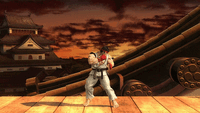
|
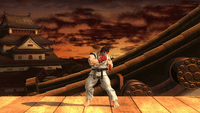
|
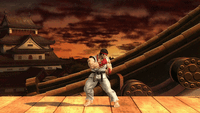
|
Idle poses
- Adjusts his gloves.
- Wriggles the fingers on both hands, then crosses his arms and pumps them.
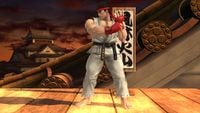 |

|
|---|
Crowd cheer
| English | Japanese | |
|---|---|---|
| Cheer | ||
| Description | Ryu! Ryu! Ryu! | Ryu! Ryu! Ryu! |
| Pitch | Male | Male |
Victory poses
- Winds back to throw a hook and assumes an upright stance while saying "Give it your all!" (必殺のタイミングを計れ!, Gauge the timing of your sure-kill!). This victory animation is directly taken from his victory pose in Street Fighter IV, with the same quote being one of several optional victory quotes that Ryu is able to speak.
- Slings his duffel bag over his shoulder while saying "The journey... has just begun." (旅はまだ…始まったばかりだ, Yet the journey... has just begun.).
- Throws an uppercut, a hook and then another uppercut while saying "Your range is one fist short." (その間合いじゃ、拳半分届かない!, That range of yours doesn't reach half a fist!). The concluding uppercut pose is a reference to one of his more recurring victory poses, where he raises his fist in the air triumphantly.
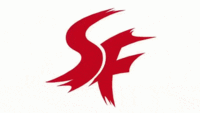 |
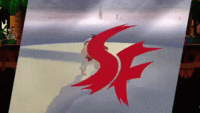 |
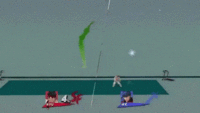
|
|---|
In competitive play
Notable players
Active
belaC - Ranked 10th on the New England Smash 4 Power Rankings. He placed 7th at GUMS 9 and 5th at Invasion 9.
b3toh - Ranked 5th on the Guadalajara Smash 4 Power Rankings.
Chanshu - One of the best Ryu players in Japan; 2nd at Karisuma Tokaigi Qualifiers; wins over Earth and 9B.
Darkshad - Ranked 1st on the Ohio Smash 4 Power Rankings. He placed 7th at both WTFox 2 and Endgame. He has wins over MKLeo, Abadango, Larry Lurr, and iStudying, and placed 9th at UGC Smash Open.
DJ Jack - Ranked 4th on the South Florida Smash 4 Power Rankings.
Klein - He is considered the best Ryu of Mexico.
Locus - Ranked 3rd on the British Columbia Smash 4 Power Rankings. 9th at 2GGT: ZeRo Saga. Has wins over Mr. R and Tweek.
NCJacobT - Previously ranked 20th on the SoCal Smash 4 Power Rankings.
Patrick
Ragna - Ranked 2nd on Manitoba Power Rankings. Known for insane losers runs after getting sent out of winners early on.
Shel
Takera
Trela - Considered by many to be the world's greatest Ryu player. Ranked 1st on the Texas Power Rankings. He placed 1st at 2GGT: Fresh Saga, 9th at EVO 2016 and The Big House 5 and 17th at GENESIS 3.
Venom - Ranked 4th on the Montreal Smash 4 Power Rankings.
Inactive
Tier placement and history
Ever since his release, Ryu has been considered a very viable character. The control input carryover from the Street Fighter series benefitted Ryu immensely, giving him excellent combo potential on his attacks out of grounded, repeated weak moves, while also giving him improved versions of three of his special attcks, namely his Shoryuken becoming a fearsome KO option at relatively low percentages. This gave him excellent tournament representation and results for his DLC status, namely from smashers like 9B, DJ Jack, Venom and, most notably, Trela. The nerfs to other top tier characters such as Diddy Kong and Sheik further contributed to his better status. Ryu's tier placement, however, was a great topic of debate due to his weaknesses, namely his trouble at approaching reliably, the buffs other characters had gained, and the release of Cloud, a DLC character that was seen just as viable as him. Despite this, he was ranked 4th on the first 4BR tier list, becoming a top-tier character.
Ryu's results would continue to decline due to the release of Corrin and Bayonetta, the buffs to Mewtwo in game updates and the spike in popularity Cloud had gained. This caused some smashers to drop him and reduced his tournament results significantly, which in turn made him rank at 9th on the second tier list, and eventually 12th on the third and current tier list. Ryu's strengths, while larger than some other top-tiered characters, are held back more than said characters by his weaknesses and very high learning curve and the dexterity to input his moves, and as such has deterred his tournament results from being as great as they initially were.
Reveal trailer
<youtube>1kalsCPXfaQ</youtube>
Trophies
- Ryu
Ryu visits from the Street Fighter series! Ryu's fighting style is based on karate, but he's mixed in some other martial arts to make his own unique style. In Smash, he will perform either weak or strong attacks depending on if you press or hold down the buttons. His special attacks also have three power levels!
Ryu makes his Super Smash Bros. debut! His fighting style is based on a form of karate, but he's mixed in some other martial arts to make his own unique style. Here his attacks can be weak or strong depending on whether you press or hold the buttons. Each of his specials have 3 levels of power using the same method.
- Ryu (Alt.)
Ryu's down special, Focus Attack, allows him to withstand a single attack and then unleash a counter. The longer you hold the button, the longer a standing enemy will be stunned if you hit them. An enemy in the air will fall slowly, defenceless. When that happens, cancel the Focus Attack and go for the knock-out!
- Shin Shoryuken / Shinku Hadoken
Use this attack when Ryu is far away from an enemy to unleash a Shinku Hadoken that penetrates through the stage. But if you use it when Ryu is close to an enemy, he'll unleash a Shin Shoryuken uppercut attack. When it hits, Ryu will follow up with his other fist and launch the opponent up, up, and away!
Ryu's Final Smash takes on two different forms depending on how close Ryu is to the enemy. If he's farther away, he'll use Shinku Hadoken, a move that pulls in any enemies nearby. If closer, he'll instead use Shin Shoryuken. He'll hit the enemy once with a powerful uppercut, then follow it up with the other fist to finish the job!
Alternate costumes
All of Ryu's costumes are based on his alternate costumes from Super Street Fighter II Turbo HD Remix.

| |||||||

|

|

|

|

|

|

|

|
Gallery
Ryu's amiibo.
Using Shin Shoryuken on Captain Falcon on Suzaku Castle.
Ryu on Orbital Gate Assault.
Preparing to use Focus Attack on Link.
Using his forward aerial on Samus.
Using Shin Shoryuken on Sheik.
Some of Ryu's alternate costumes.
Using Shakunetsu Hadoken.
Using Joudan Sokutogeri on Pit.
Ryu's being screen KO'd.
Trivia
- Ryu's attributes generally follow the mechanics of his home series:
- He can perform special moves without using the special button; he can perform them using a specific directional input and the standard attack button. This replicates the process of performing special moves in Street Fighter and most traditional fighting games.
- This also makes him the only character in the series who is able to perform his neutral special after obtaining a Smash Ball, although Kirby may also perform his neutral special after obtaining a Smash Ball if he has first inhaled Ryu.
- All of Ryu's attacks emit sound effects directly taken from Street Fighter II if landed. This makes Ryu the second character to emit unique sound effects when fighting, with the first being Snake and the third being Cloud. Coincidentally, all three are third-party characters.
- His shield also emits a unique sound effect if hit, and a perfect shield emits the parry sound effect from Street Fighter III: 3rd Strike. This makes him the only character to emit separate sound effects while defending.
- Ryu's very slow air acceleration is a nod to how jumps function in the Street Fighter series, in which they follow an arc and cannot be made to change direction once initiated.
- Ryu's tapped and held inputs are a reference to the original Street Fighter, where the player had to tap the button for weaker attacks, or hold it for stronger ones. They also, to some extent, incorporate the light, medium, and heavy classifications of attacks that became the series' standards.
- The beginning of his dash causes him to do a quick shuffle forward, replicating his dash from Street Fighter III onward. This shuffle is entirely aesthetic and has no unique function, although it does require more precision in the player's inputs to dash-dance properly.
- Collarbone Breaker's shield breaking property is based off of its usage as an overhead in his home series, in which it is frequently used as a way to attack opponents who are blocking low.
- Ryu's tapped neutral attack must hit an opponent to initiate the rest of the combo, referencing Target Combos.
- He can perform special moves without using the special button; he can perform them using a specific directional input and the standard attack button. This replicates the process of performing special moves in Street Fighter and most traditional fighting games.
- Ryu is the first and only character in the Super Smash Bros. series to possess two Final Smashes in the same game.
- The ability for Ryu to perform one of two Final Smashes is a possible reference to the Ultra Combo Double mechanic introduced in Ultra Street Fighter IV, in which fighters can perform one of their two Ultra Combos at the cost of less attack power than only using a single preset Ultra Combo.
- Ryu's face-up prone position is identical to his KO'd pose from his home series.
- Ryu, Roy, Cloud, Corrin, and Bayonetta are the only characters (who are all coincidentally DLC) to emit different voice clips when using battering items.
- Ryu is the only third-party character in SSB4 (and the second overall, after Snake) who cannot wall jump.
References
| Fighters in Super Smash Bros. 4 | |
|---|---|
| Veterans | Bowser · Captain Falcon · Charizard · Diddy Kong · Donkey Kong · Dr. Mario · Falco · Fox · Ganondorf · Ike · Jigglypuff · King Dedede · Kirby · Link · Lucario · Lucas · Luigi · Mario · Marth · Meta Knight · Mewtwo · Mr. Game & Watch · Ness · Olimar · Peach · Pikachu · Pit · R.O.B. · Roy · Samus · Sheik · Sonic · Toon Link · Wario · Yoshi · Zelda · Zero Suit Samus |
| Newcomers | Bayonetta · Bowser Jr. · Cloud · Corrin · Dark Pit · Duck Hunt · Greninja · Little Mac · Lucina · Mega Man · Mii Fighter (Mii Brawler · Mii Gunner · Mii Swordfighter) · Pac-Man · Palutena · Robin · Rosalina & Luma · Ryu · Shulk · Villager · Wii Fit Trainer |
|
| |
|---|---|
| Fighters | Ryu (SSB4 · SSBU) · Ken (SSBU) |
| Assist Trophy | Guile |
| Stage | Suzaku Castle |
| Trophies and Spirits | Trophies · Spirits |
| Music | SSB4 · Ultimate |
| Other | World Tour |
